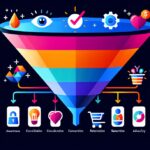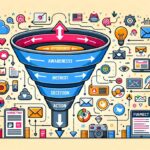How Landing Pages Affect Ad Conversion Rates

In today’s fiercely competitive digital marketing landscape, businesses are constantly on the lookout for strategies that maximize their ad conversion rates. With online advertising budgets soaring, achieving those crucial conversion rates not only boosts return on investment but also fuels business growth. Unfortunately, many marketers encounter challenges in realizing these optimal results, often due to ineffective sales funnels and poorly designed landing pages.
A sales funnel acts as a guiding pathway that directs potential customers from the moment they express initial interest, through various stages of persuasion, to the ultimate conversion step. Meanwhile, a landing page serves as the critical first point of engagement that can either captivate the audience or dilute their interest. If these elements do not seamlessly coordinate with the overall marketing strategy, they can pose significant barriers to effective conversions.
To bridge this gap, the creation of cohesive sales workflows, well-structured landing pages, and strategic email automations is vital. These components, when optimized and integrated, enhance ad conversion rates by ensuring a smooth, engaging, and personalized journey for the prospect, ultimately driving business growth.
One powerful tool that aids in achieving this optimization is ClickFunnels. ClickFunnels provides an intuitive platform that enables marketers to design and implement sales funnels with minimal coding expertise. By offering features like easy-to-customize landing pages, comprehensive workflows, and automated email sequences, ClickFunnels empowers businesses to streamline their marketing efforts and achieve higher conversion rates efficiently. You can try it for free.
This blog post will delve into the nuances of creating effective sales funnels, compelling landing pages, and robust email automation strategies. By understanding the interplay between these elements, marketers can build an effective sales process that not only captures attention but also converts leads into loyal customers. Investing time and effort into optimizing these essential components is key to unlocking the full potential of your digital marketing campaigns.
Understanding the Role of Landing Pages in Ad Conversion
Landing pages are more than just a digital doorstep; they are the first meaningful interaction that potential customers have with your brand after clicking on an advertisement. Whether the ad comes from a search engine or social media, the landing page needs to resonate with the visitor instantly, holding their interest and directing it toward a conversion goal.
The effectiveness of a landing page can significantly affect your conversion rate. Studies suggest that aligning the landing page content with the ad message is crucial. This alignment ensures that when a prospect lands on your page, they find exactly what they were promised in the ad. Here are some pivotal elements to consider for optimizing landing page design:
Consistent Messaging
The landing page should echo the message and tone of the ad that brought the visitor there. From the headline to the visuals and copy, ensuring consistency helps in validating the visitor’s decision to click. This harmony not only holds attention but also builds immediate trust.
Clear Calls to Action (CTAs)
Every well-designed landing page must feature prominent and persuasive calls to action (CTAs). These are the actions you want your visitors to take, whether it’s signing up for a trial, downloading a resource, or making a purchase. Having a clear and direct CTA, coupled with strong value propositions, guides the user toward conversion.
Optimized Page Speed
The speed at which your landing page loads can make or break the user’s experience. A delay of even a few seconds can lead to higher bounce rates, potentially resulting in lost conversions. Ensuring that your page is optimized for fast load times is essential to keeping visitors engaged.
Seamless User Experience
A seamless and intuitive user experience (UX) is crucial. This means simple navigation, mobile responsiveness, and a layout that naturally guides the eye toward the desired action. By reducing friction, you increase the chance that visitors will convert.
Utilizing tools like ClickFunnels can help streamline the creation and optimization of landing pages. ClickFunnels offers features designed to enhance every aspect of your page, from design and content to functionality, allowing you to concentrate on crafting a compelling journey for your visitors without the need for deep technical expertise.
By paying attention to these critical aspects, your landing pages will not only improve conversion rates but become an integral part of an effective sales funnel. Understanding how landing pages affect ad conversion rate can guide the continuous optimization efforts necessary for achieving outstanding results.
Creation of Sales Funnels and Sales Workflows
In the intricate dance of digital marketing, crafting successful sales funnels and sales workflows is paramount. These components guide potential customers through a conversion journey from the spark of initial interest to the glow of a final purchase. This journey is an art and a science, requiring careful planning and execution.
Identifying Customer Personas
The first step in building a powerful sales funnel is to understand your audience through customer personas. These are detailed representations of your ideal customers, built using real data and strategic insights. Understanding what drives your audience, their challenges, and their needs allows you to tailor your sales funnel in a way that resonates and engages.
Tailoring Messaging
Once you have clear customer personas, the next step is to customize your messaging according to different stages of the buyer’s journey. This journey begins with awareness, moves into consideration, and culminates in decision. At each stage, your messaging should align with the prospect’s current mindset and needs. Engaging content that nurtures and persuades is key, whether it’s through informative blog posts, compelling landing pages, or targeted ad copy.
Leveraging Automation Tools
To ensure timely and relevant follow-ups, automation tools play a critical role in the modern sales workflow. By implementing automation, marketers can efficiently manage leads, send targeted emails, and execute timely reminders or offers. Automation allows your sales funnel to operate seamlessly, providing a personalized experience without manual effort.
One tool that excels in this domain is ClickFunnels. ClickFunnels is a robust platform that simplifies the creation of sales funnels by offering out-of-the-box templates and automation features. This allows marketers to focus on crafting content and strategy instead of wrestling with technical hurdles.
Understanding the Stages
A successful sales workflow involves understanding how each stage of your funnel fits together cohesively. From capturing leads via attention-grabbing ads and landing pages to nurturing them through email sequences, each step must lead seamlessly to the next. The interconnectedness of these stages forms an optimized path that is designed to convert leads to customers.
By building a well-orchestrated sales funnel, grounded in detailed customer understanding and supported by strategic automation, marketers can create a streamlined process that significantly boosts their conversion rates. While the role of landing pages is crucial in this setup by affecting ad conversion rates, integrating them into a broader, well-structured funnel ensures leads don’t just visit but become engaged, loyal customers. Investing in this process is essential for leveraging digital marketing potential fully.
Leveraging Email Automations for Enhanced Conversions
In the realm of digital marketing, email automation emerges as a critical component of an effective sales strategy. By enabling marketers to send personalized content precisely when it matters most, email automations nurture leads, retain customers, and significantly boost conversion rates through consistent communication across the sales funnel.
The Power of Segmentation
Effective email automation starts with thoughtful segmentation. Segmentation involves dividing your audience into distinct groups based on shared characteristics, behaviors, or interactions with your brand. This allows you to tailor content and offers that resonate specifically with each segment, enhancing engagement.
Consider employing criteria such as demographics, purchase history, or engagement level to create your segments. By doing so, you ensure that each lead receives messaging that is relevant to their needs and interests, increasing the chances of moving them further along the sales funnel.
Crafting Compelling Email Content
Once you have your segments, focus on crafting compelling email content. This involves writing engaging subject lines, personalizing messages, and including clear and persuasive calls to action (CTAs). Your emails should address pain points, offer solutions, and provide value to your audience.
Personalization is key, as it makes your communication feel more human and less like a generic broadcast. Use your data wisely to address your audience by name, reference past interactions, and suggest products or services aligned with their interests.
Utilizing Analytics for Improvement
To refine your email campaigns over time, leveraging analytics is crucial. Monitor metrics such as open rates, click-through rates, and conversion rates to gather insights on what works and what doesn’t. This data can reveal patterns in your audience’s behavior, allowing you to adjust your strategies accordingly.
Iterate on your email content and segmentation strategies based on these insights, continuously optimizing for better results. Set benchmarks, conduct A/B tests, and remain responsive to your analytics to ensure your email campaigns evolve with your audience’s preferences.
For marketers seeking a comprehensive solution to implement and manage their email automations seamlessly, ClickFunnels offers a powerful platform. ClickFunnels not only simplifies the creation of effective sales funnels and landing pages but also integrates robust email automation features. By using ClickFunnels, you can automate emails across various customer journey stages, ensuring timely and relevant communication, all without needing advanced technical skills.
Incorporating email automation into your sales strategy enhances your capacity to maintain continuous engagement with leads, guiding them toward conversion and fostering customer loyalty. Integrating these automated efforts with your landing pages and sales funnels can transform your marketing efforts into a finely tuned conversion machine, driving business growth.
Conclusion
In summary, creating well-structured sales funnels, optimizing landing pages, and employing strategic email automations are all paramount in boosting ad conversion rates. Each component serves a unique purpose yet works harmoniously to craft a cohesive and engaging path from the first moment of customer interest to the final conversion.
A well-designed sales funnel ensures that prospective customers are guided smoothly through every stage of their journey. By identifying and understanding different customer personas, marketers can tailor their messaging effectively, ensuring that each interaction feels personalized. This personalization is crucial for nurturing leads and converting them into customers.
Optimizing landing pages is equally important. These pages act as the first point of contact after a user clicks on an ad, making them a critical factor in maintaining the interest sparked by the advertisement. From ensuring consistent messaging to providing seamless user experiences, each element of a landing page impacts its effectiveness in driving conversions.
Meanwhile, strategic email automation complements these efforts by maintaining a consistent flow of communication with leads. By segmenting audiences and tailoring messages to specific groups, marketers can ensure that their emails remain relevant and engaging, increasing the likelihood of lead conversion.
By understanding and leveraging the interplay between sales funnels, landing pages, and email automations, marketers can craft a highly effective sales process. This not only attracts potential customers but also guides them towards becoming loyal advocates for your brand.
To streamline the creation and management of these critical components, a tool like ClickFunnels proves invaluable. ClickFunnels offers an intuitive platform designed to simplify the process of building optimized sales funnels, customizable landing pages, and elaborate email automation sequences. With its user-friendly features, even those with minimal technical expertise can create a robust marketing strategy tailored to achieve higher conversion rates. You can try it for free.
Investing the necessary time and resources into optimizing sales funnels, landing pages, and email automations will undoubtedly lead to significant improvements in conversion metrics, ultimately contributing to the success and growth of your business. The integration of these elements, powered by platforms such as ClickFunnels, positions you to maximize your digital marketing efforts, turning prospects into repeat customers and driving sustained business growth.





